Munich is a large city with over half million inhabitants, having a good layout of the streets.
Many of the streets of Munich, especially in the historic centre are popular places for walking and shopping. Along the streets located important sights of the city and(or) historical monuments, there are also cafes, bars and restaurants, boutiques and shops, salons and hotels.
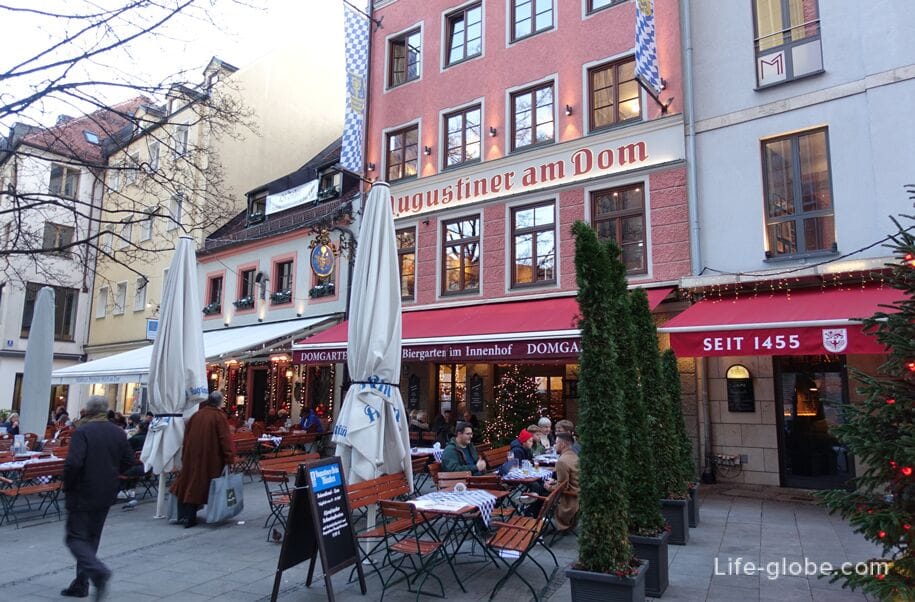

This article lists the "major" - the most attractive, colorful, interesting and visited the streets of Munich.
Street in the old town of Munich
Street Sendlinger Strasse
Street Sendlinger straße underground station (Sendlinger Straße) runs from gate Sendlinger tor (Sendlinger Tor) to the North-East to the point where street Furstenfelder straße (Fürstenfelder Straße) meets Rindermarkt (Rindermarkt).
The street was known since 1318 and is a historic, pedestrian and shopping street, along which is located a historical building with Bay Windows (now restored), also there are more new buildings and major landmarks:
- the former house of the brothers Azam (Asamhaus) and in the Heart of Munich (Asamkirche), together representing an architectural ensemble and a masterpiece of the late Baroque;
- a historical monument - the house Ruffini (Ruffinihaus), consisting of a group of three houses and built by Gabriel von Zeidler at the beginning of the 20th century. Read more about the street Sendlinger straße...
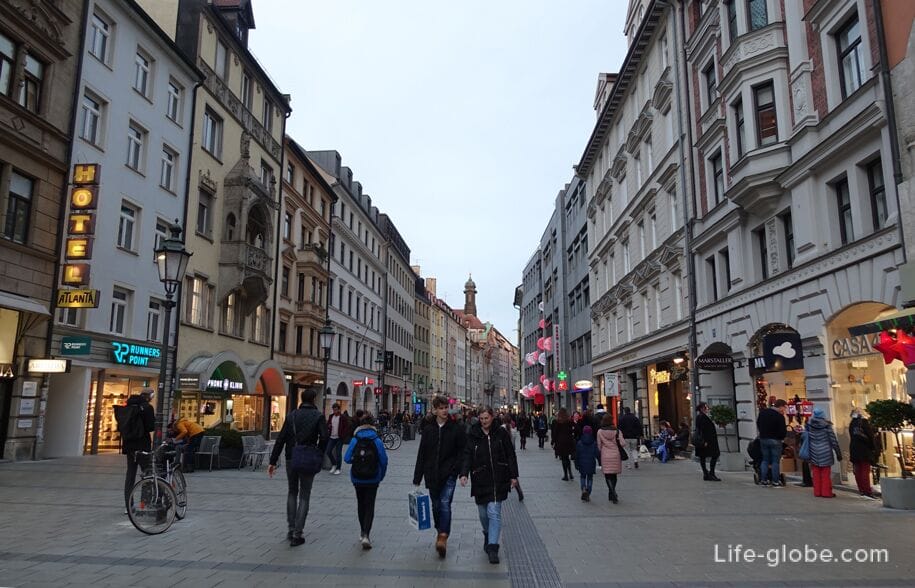

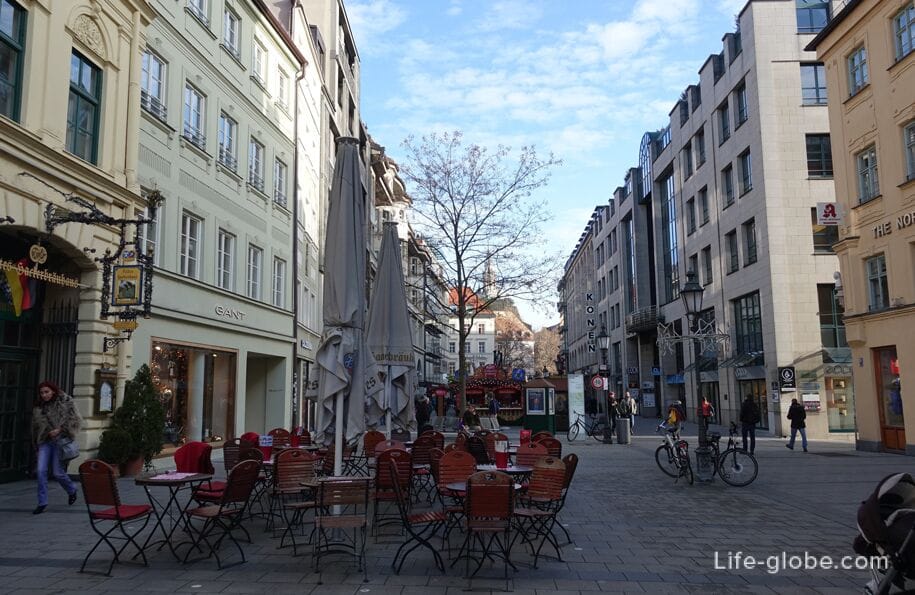
Rindermarkt
Rindermarkt (Rindermarkt) is both a street and a square.
"Rindermarkt" means "Cattle market" and is also known as "Cow market".
Originally this area was used as a market square for trading cattle. Later the rich patricians built on Rindermarkt houses.
In the center of the square is the fountain "Rindermarkt" (Rindermarktbrunnen) with a sculptural composition, which celebrates the historic function of the former cattle market.
The North-Eastern extremity of Rindermarkt marks St. Peter's Church (Peterskirche), originating from the 11th century and in the tower-the bell tower of which is a circular observation deck.
In the Eastern part of Rindermarkt located the Lion's tower (Löwenturm / Levinter), which is the oldest building and, most likely, was erected as a water tower for a city Park or building for drainage and was also used as a tower room. Read more about Rindermarkt...
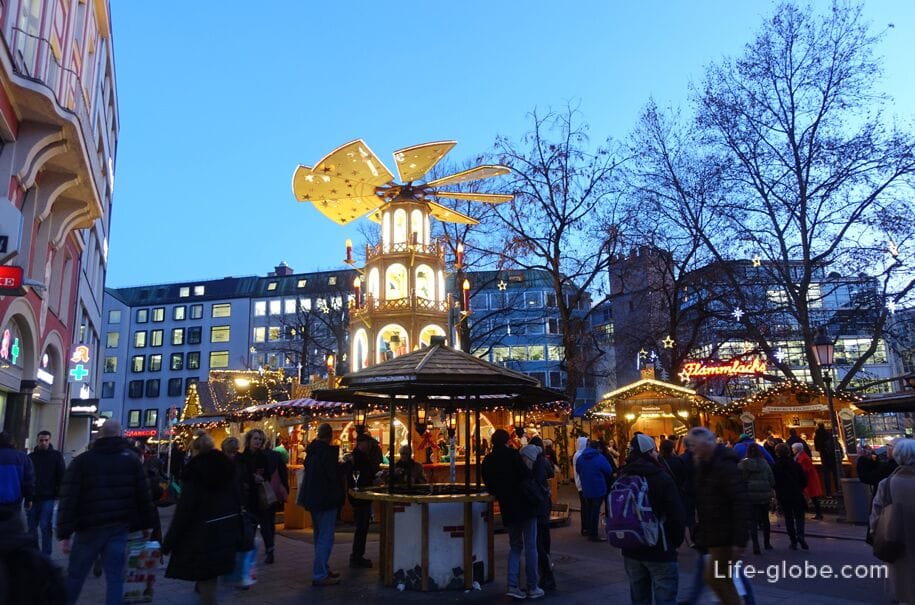
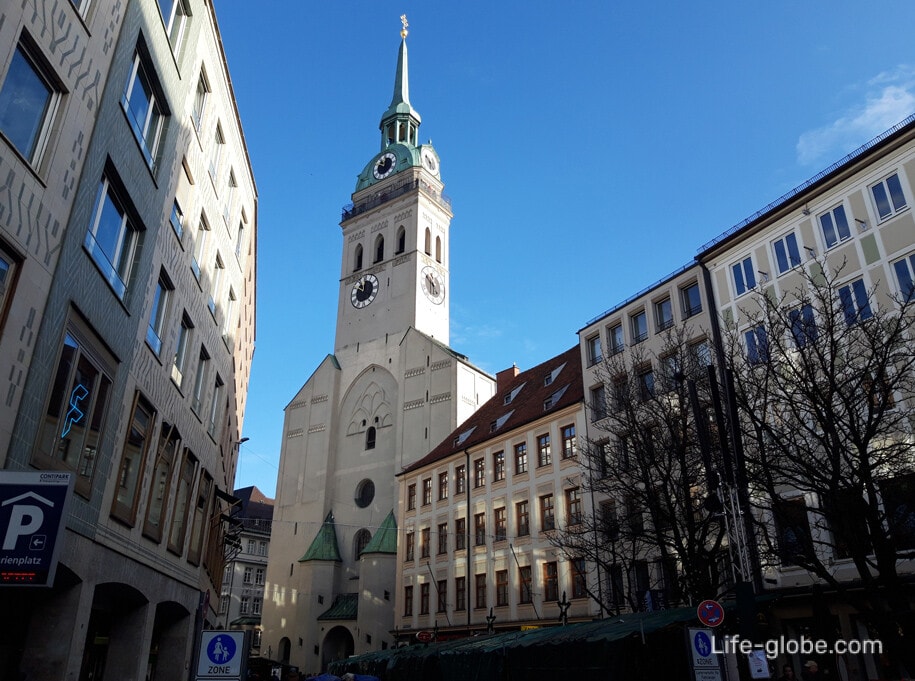
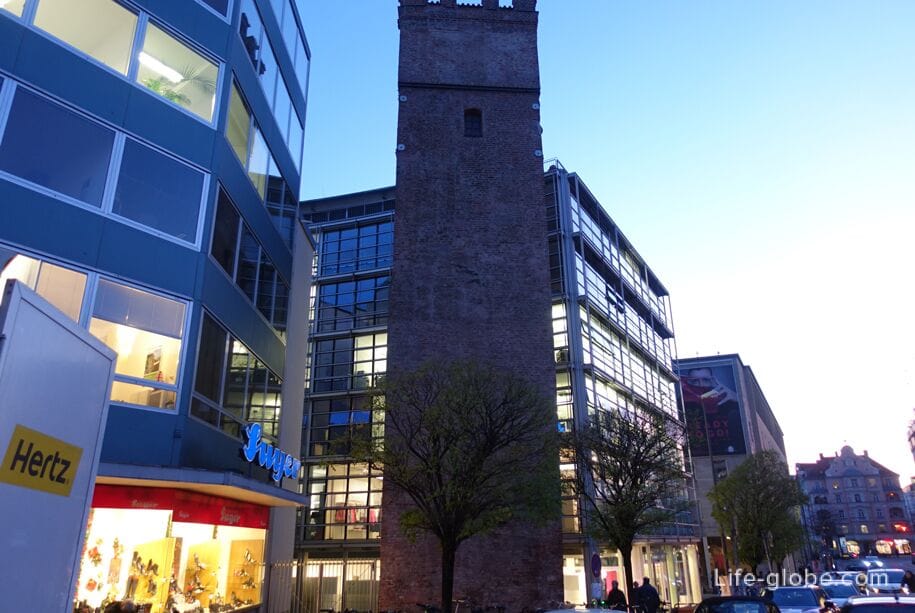
Street Kaufingerstrasse and Neuhauser Strasse
Street Kaufingerstrasse and Neuhauser Strasse (Kaufingerstraße, Neuhauser Straße) to merge with each other and together constitute the Central pedestrian zone and one of the most important commercial axes of Munich.
The streets stretch from the Central square of the city of Marienplatz in the West to Karlovy gate (Karlstor) and Karlsplatz square (Karlsplatz).
Along the streets are all located:
- "House beautiful towers" (Haus zum Schönen Turm), which is connected with the Munich urban legend, and whose name refers to a former gate tower, "Schönen Turm", formerly placed before this house and which was part of the old city wall.
the former Augustinian Church (Augustinerkirche), Augustskola belonged to the monastery built in the 13th century. Today, the Church hosts the German Museum of hunting and fishing (Deutsches Jagd und Fischereimuseum);
- St. Michael's Church (Jesuitenkirche St. Michael), which is considered the largest and the first Renaissance Church North of the Alps;
- the building of the Old Academy (Alte Akademie) - a former Jesuit College, built in the 16th century and today used for retail, offices and gastronomy;
- Church Burgerzaal (Bürgersaalkirche) - the Civic hall (Bürgersaal), erected in 1709 and 1710, respectively, as the new chapel and meeting room for meetings of the Marian congregation of men of the community "the Annunciation". Read more about the streets Kaufingerstrasse and Neuhauser Strasse...
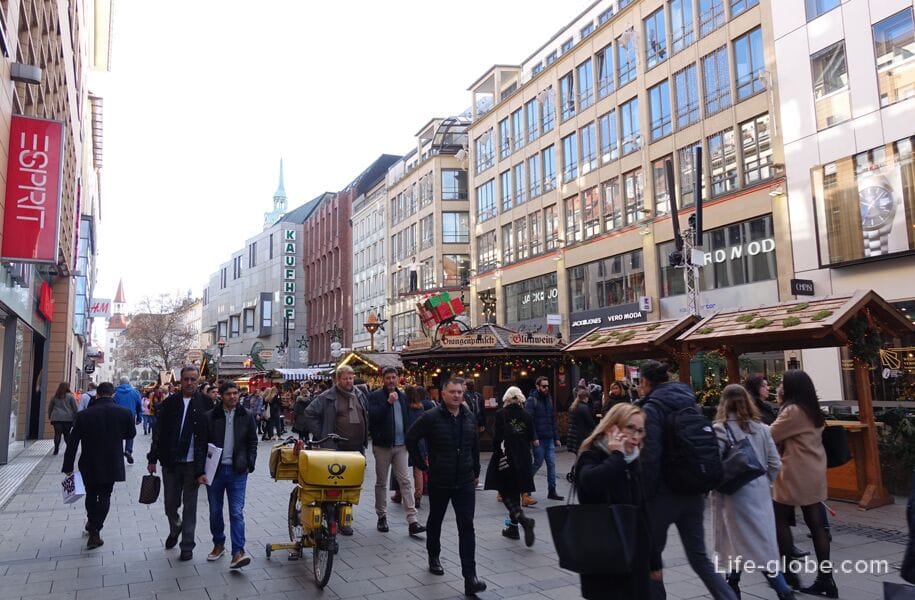
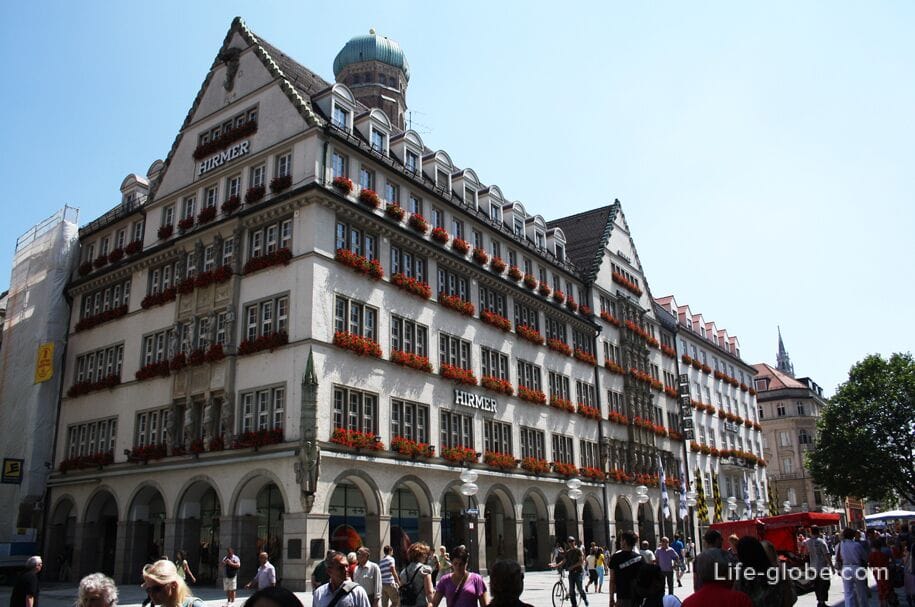
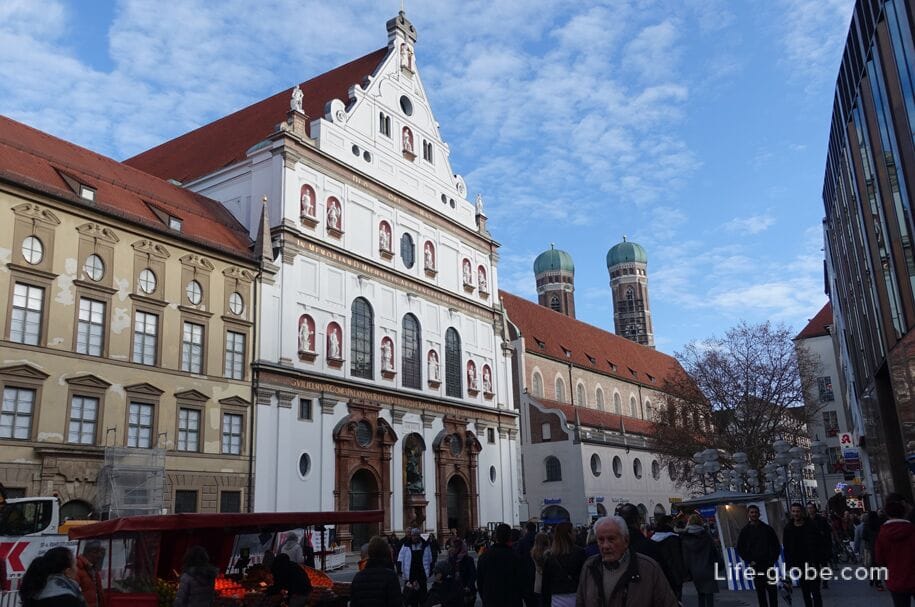
Street Cardinal Faulhaber's
Street Cardinal Faulhaber's (Kardinal-Faulhaber-Straße / the Cardinal Faulhaber's Strasse) is located in the North-Western part of the old town of Munich and in the past was the place where was erected by aristocratic palaces and public buildings.
The sights of the streets:
- Mangala Palace (Palais Montgelas), built in 1811-1813 years for count Maximilian Joseph von Mangala in the style of classicism.
From 1969 to the present, the Palace is integrated - is part of a historic 5-star hotel Bayerischer Hof;
- the monument to Kurt Eisner (Kurt-Eisner-Denkmal), which is a metal floor plate installed under the open sky on the pavement to commemorate the assassination on 21 February 1919 at the site of the first Prime Minister of Bavaria Kurt Eisner;
- also: Porcia castle (Palais Porcia); the former Bavarian mortgage exchange Bank (Bayerische Hypotheken - und Wechsel-Bank); the Archbishop's Palace (Erzbischöfliches Palais) - the former Palace of Holnstein (Palais Holnstein); Spreti Palace (Palais Spreti); the former branch of the Royal Bank (Ehem. königliche Filialbank) and the Greek Orthodox Church of St. Salvator (St. Salvator, Salvatorkirche / Salvatorkirche), made in the late Gothic style. Read more about street Cardinal Faulhaber's...

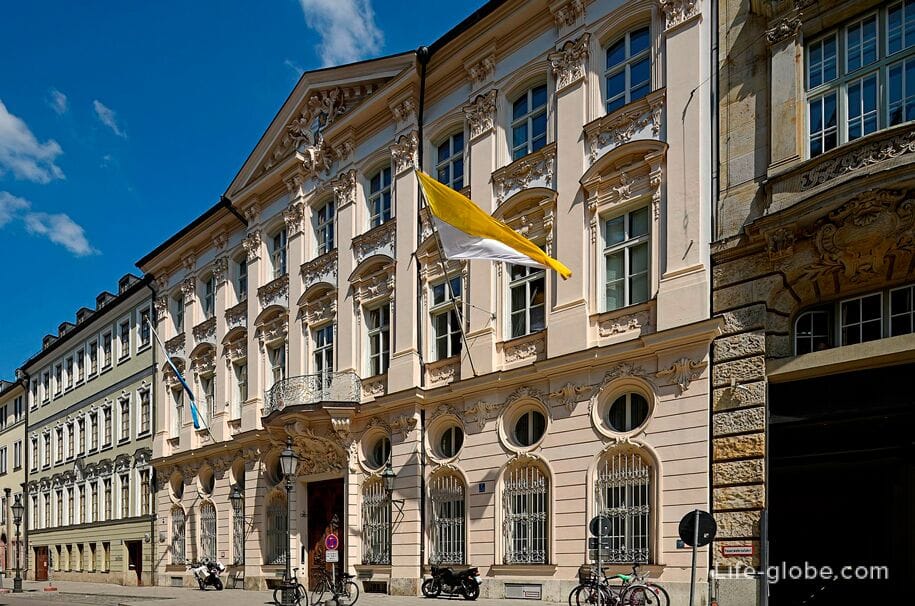
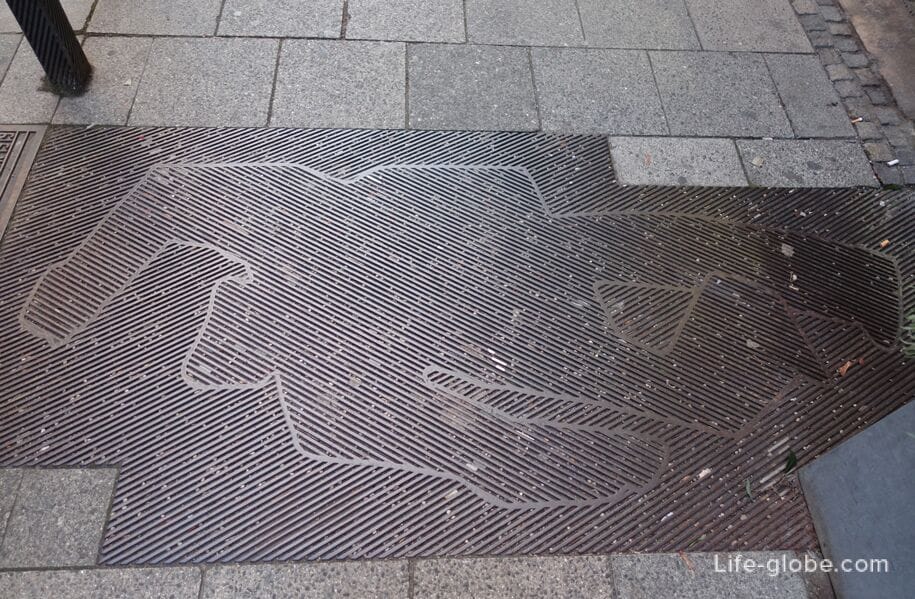
Street Residence
Street Residence (Residenzstraße / Residenciales) is the link between two important squares of the city: the square Odeonsplatz and area of Max Joseph (Max-Joseph-Platz).
Most of the street is a pedestrian zone.
Along remarkable:
- Preising Palace (Palais Preysing) - a former mansion in the Rococo style, which served as the residence of the counts of Pasinkov and built between 1723 and 1728 years;
- the wing of the Munich residence, which stretches along the street for a quarter and due to which the street got its name;
- historic buildings (now restored) and buildings that stretch along the West side of the street Residence which was previously the home of the middle class;
- Palace Tering-Jettenbach (Palais Toerring-Jettenbach), built in the 18th century in the Rococo style, and at the time was the most sophisticated aristocratic Palace of Munich. Read more about street Residence...
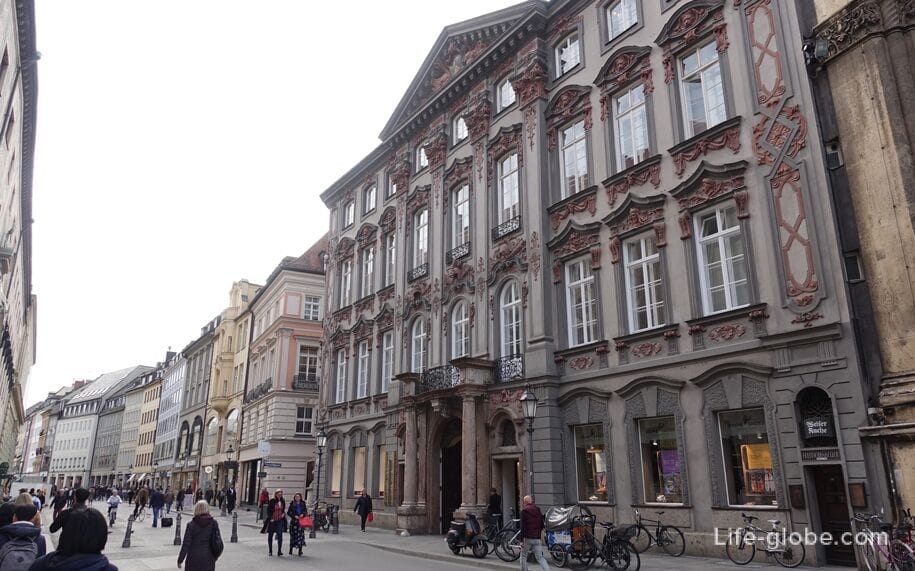
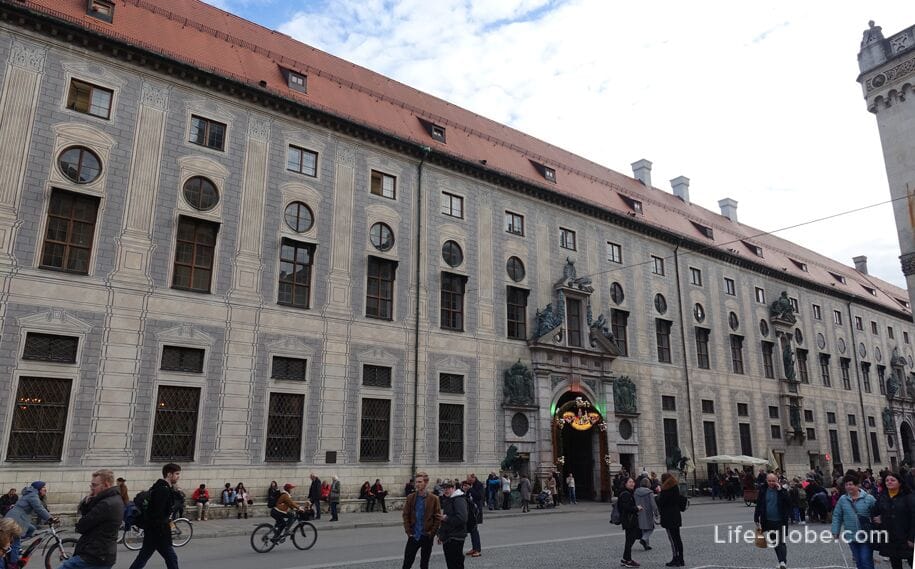
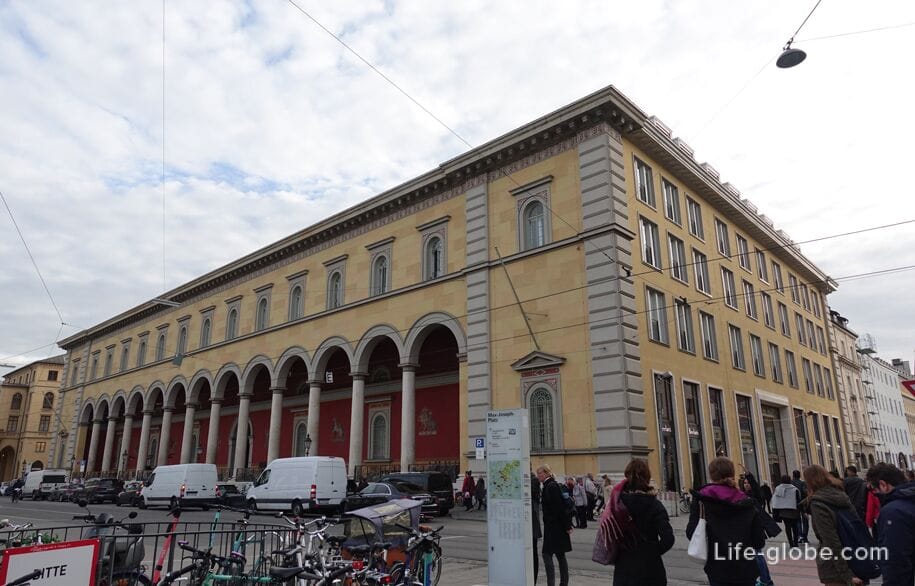
Street Burgstraße Underground Station
Street burgstraße underground station (Burgstraße) is one of the oldest urban streets of Munich. The street name has been registered with the 1364.
Burgstraße underground station connects two important places of interest in Munich: the former Ducal Palace and Imperial residence of the rulers of Bavaria - the Old courtyard (Alter Hof) with the Old town hall (Altes Rathaus).
Along remarkable:
- entrance tower of the Old courtyard, with an arched passageway leading to the courtyard of the former Ducal castle;
- the building of Weinstadl (Weinstadl), which is one of the oldest surviving townhouses in Munich, erected in 1500. Read more about the street burgstraße underground station...


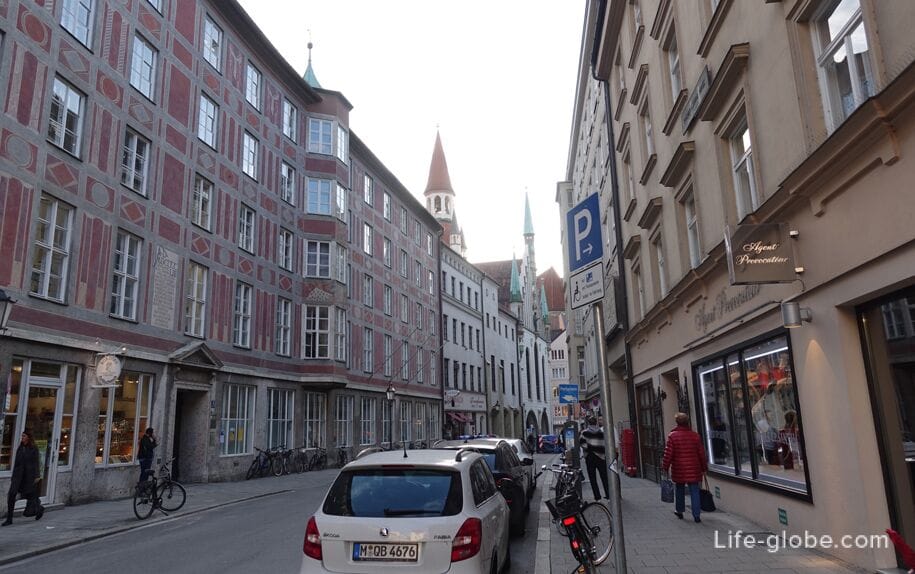
Street Backenstose
Checkinstance (Hackenstraße) - unextended street in the old town, is attractive because it is located along such:
- Hundskugel - one of the oldest surviving town houses in Munich. On the house you can see the date "1440";
- the house of Radspieler (Radspielerhaus) - former Palace of the assistance of rechberg (Rechberg Palais), built in 1678 on the site of two other buildings, the complex of buildings with an inner courtyard.
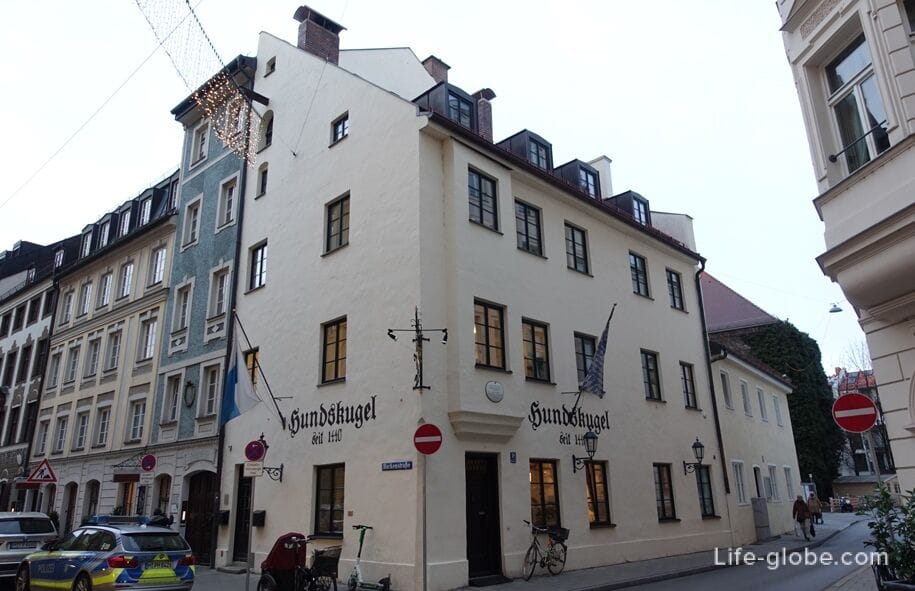
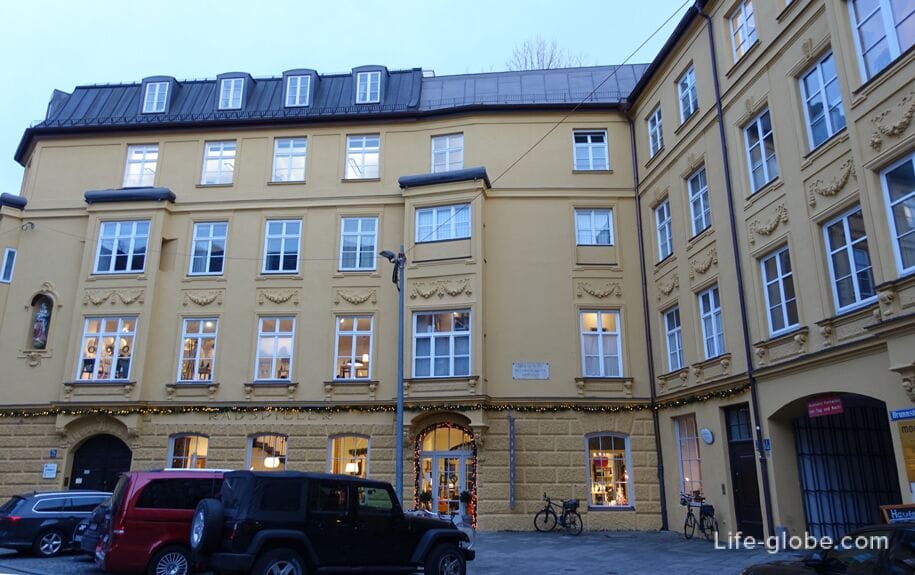
Of streets departing from square Platzl
Platzl (das) is one of the most beautiful public squares in the historic part of Munich.
Near the square is notable streets that lead directly to the square.
Along the streets are characterized by historic buildings, shops, souvenir shops, cafes and restaurants. Read more about square Platzl...
Street Orlandostrasse (Orlandostraße)
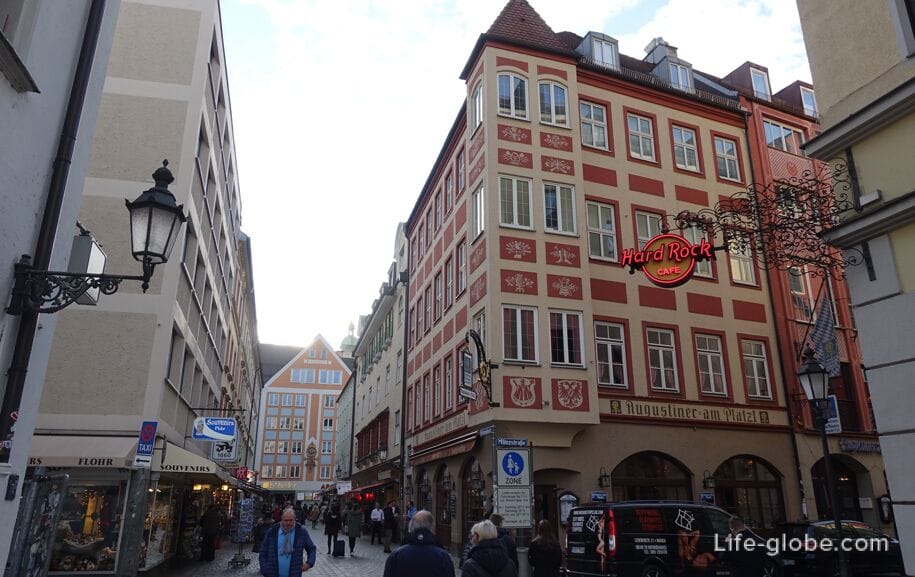
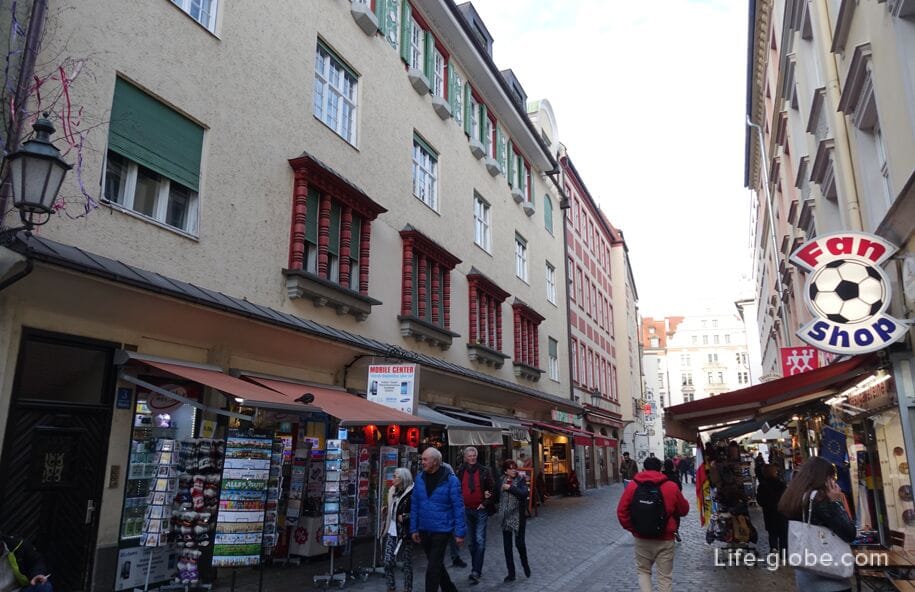
Street Protersters (Pfisterstraße)
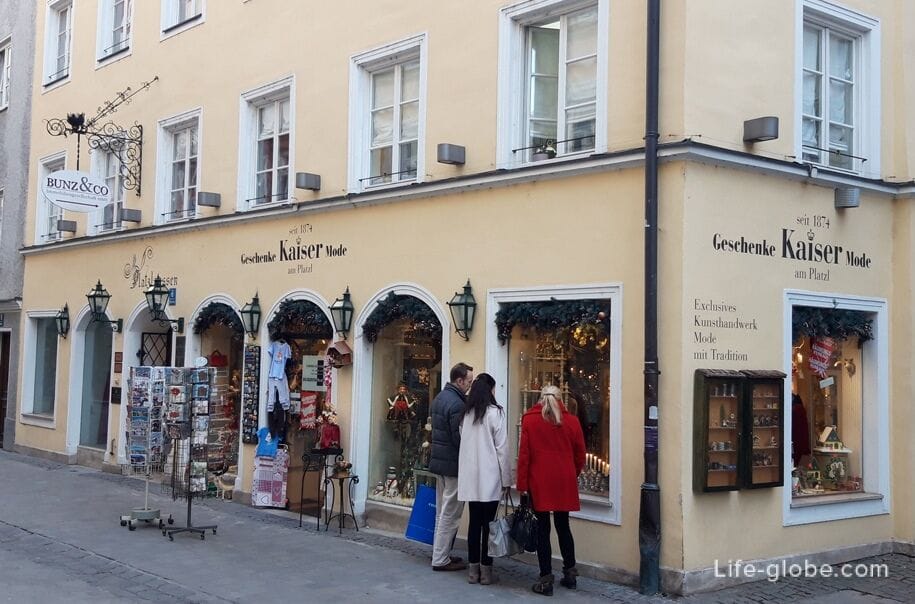


Street Tal
Street tal (Tal), originally part of the Bavarian salt road Salzstrasse.
The street stretches from the Old town hall to the Isartor city gate.
Along remarkable:
historical building of the Bank "Stadtsparkasse München", which was erected in several stages, starting from 1889;
- Church of the Holy spirit (Heiliggeistkirche), which is one of the oldest churches in Munich, whose history dates back to the 13th century;
- Bleak house (Kalter-Haus / Cutler-house), which is a residential and commercial building, and with the history of which is closely related to the men's store "Golden 19";
- building Sterneckerbrau (Sterneckerbräu) - formerly of the eponymous brewery. Read more about the street Tal...
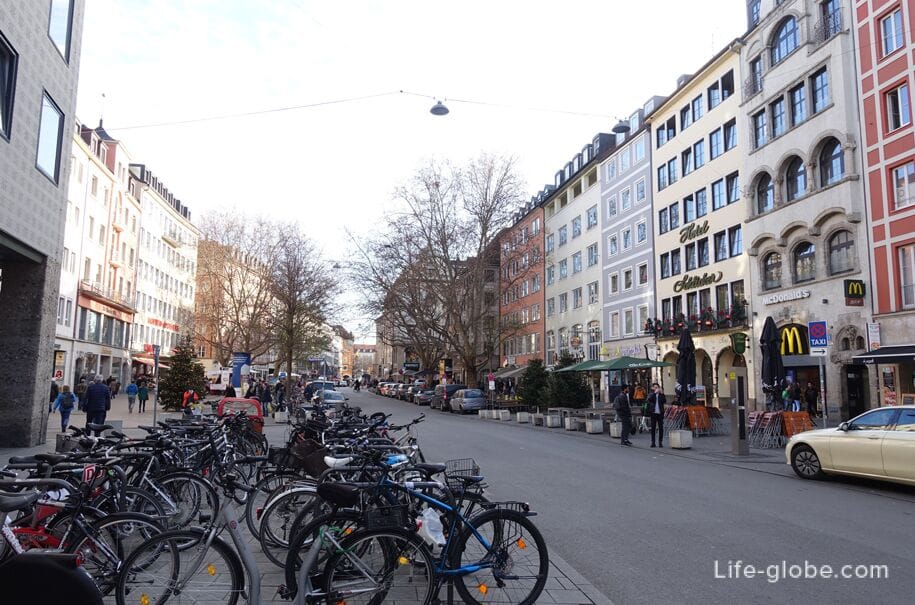
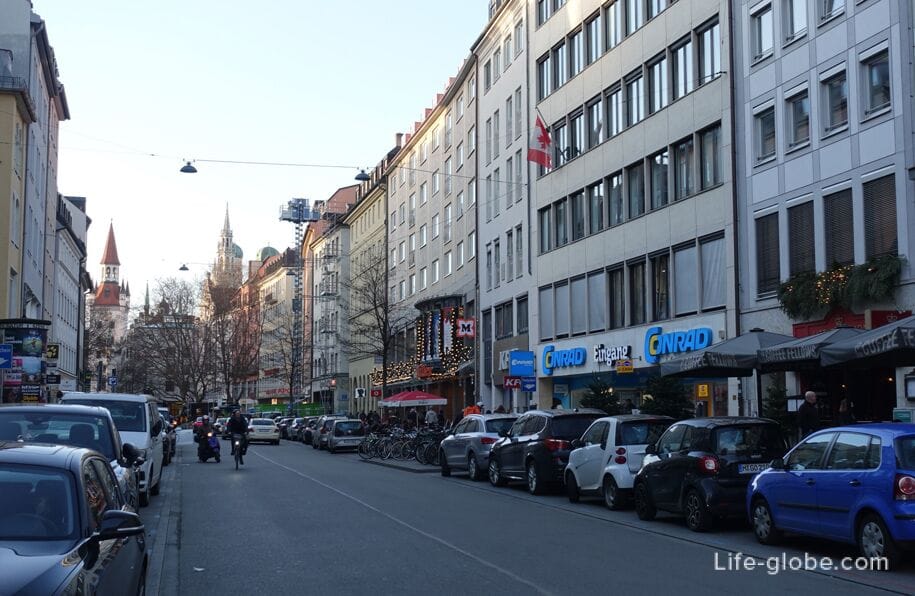
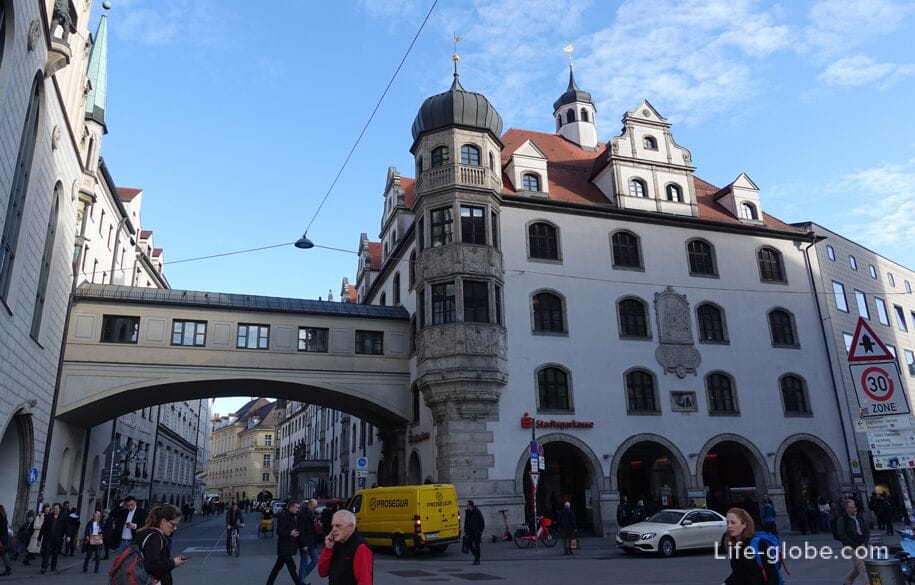
Also in the Old town of Munich attractive streets: Persistence (Perusastraße), Theatinerstrasse (Theatinerstraße), Falkenturmstrasse (Falkenturmstraße), etc. read More about Munich's old town...

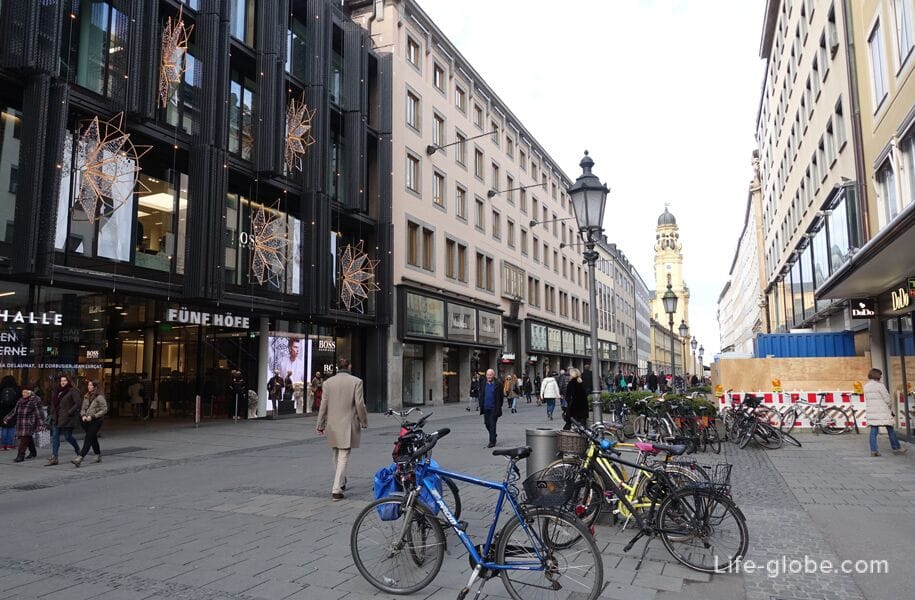
Royal avenues
In the 19th century in Munich was built four Royal Avenuethat led from the city centre.
Royal avenues are now an important urban boulevards located in the heart of Munich and along which are located, including museums, former palaces and magnificent buildings.
Brienner Strasse
Briennerstrasse (Brienner Straße) was built in the neoclassical style with 1812.
Street Brienner stretches from the Northern edge of Munich's old town (the square Odeonsplatz underground station) in a North-westerly direction to Nymphenburger straße (Nymphenburger Straße).
The length Briennerstrasse is about a mile.
The street crosses three significant areas of the city: the square of Wittelsbach (Wittelsbacherplatz), which is considered the most beautiful square in the classical style in the Munich area Karolinenplatz, the center of which is decorated by high obelisk and the Royal square (Königsplatz), which are two of the Museum (Glyptothek and the State antique collection) and ceremonial gates - the Propylaea. Read more about Avenue Briennerstrasse...
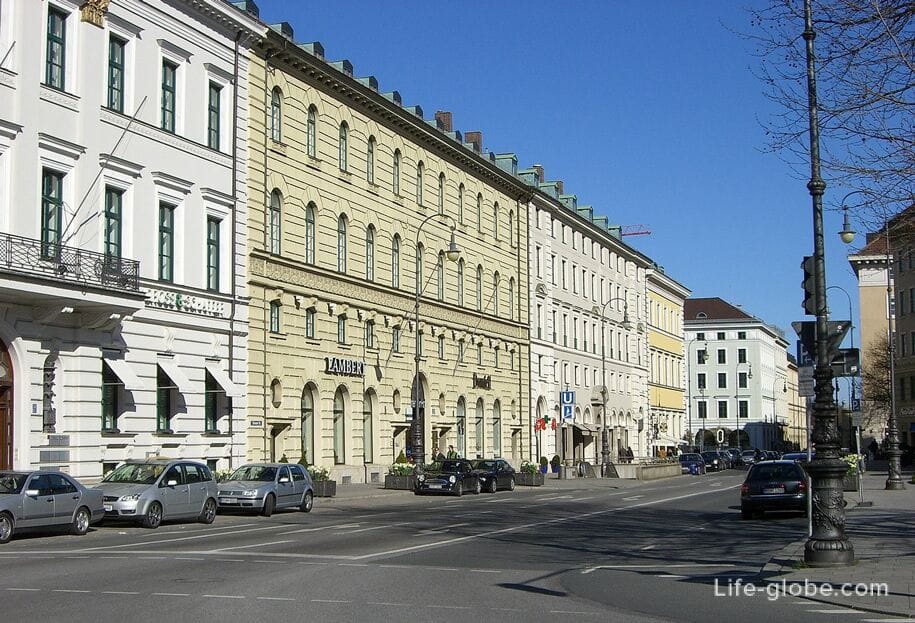

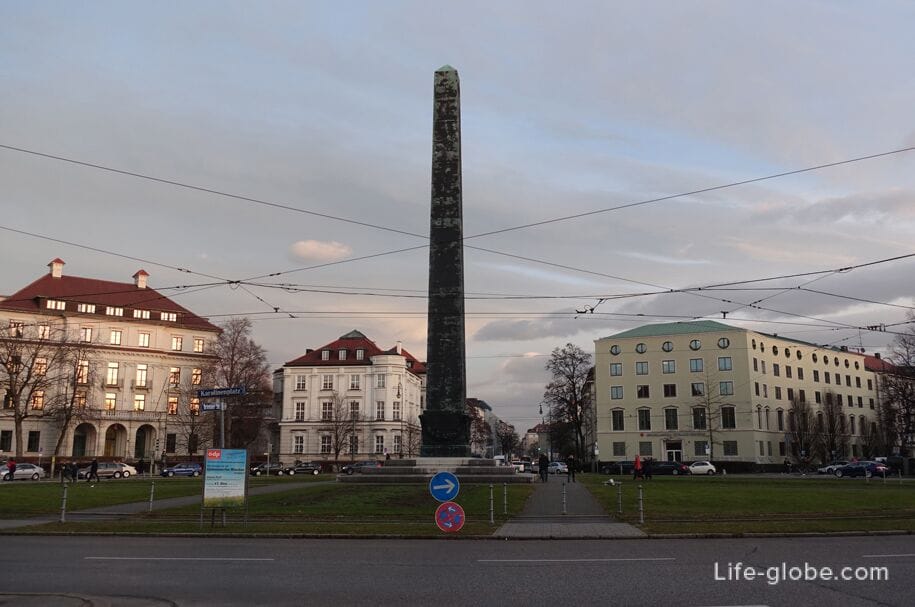
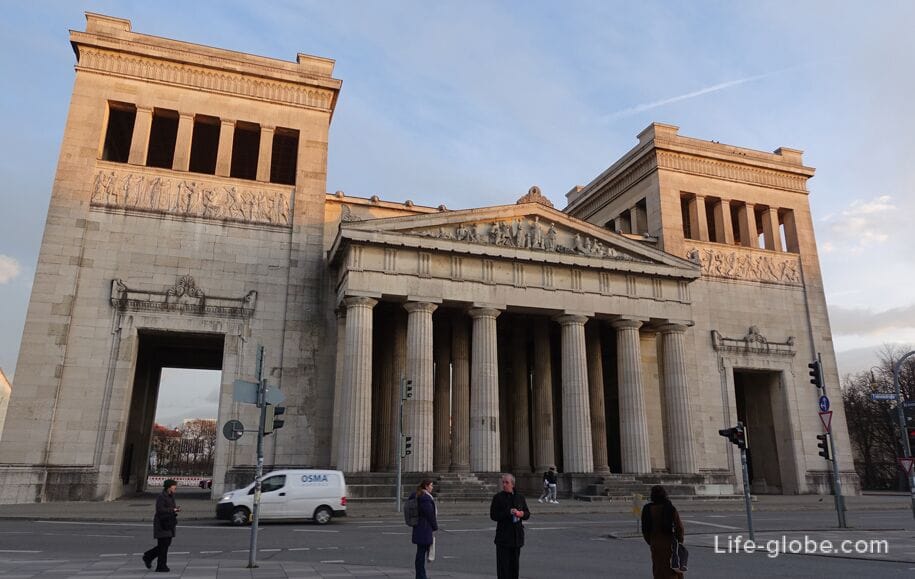
Ludwigstraße
Ludwigstraße (Ludwigstraße) was built on the initiative of king Ludwig I of Bavaria (and named in his honor), starting in 1816 as a "great" street, representing the Bavarian Kingdom.
The length of the street is just over 1 kilometer, it stretches from the square Odeonsplatz is absolutely right in a North-easterly direction and ends at the gates of Victory.
The main objects on ludwigstraße: the building of Bavarian archival Bureau, building of the Bavarian state social court, the Bavarian state library, the Church of St. Ludwig, Roman Catholic Seminary, the University Ludwig-Maximilian, fountains, memorial White rose and the Victory gate - a majestic arch, dedicated to the glory of the Bavarian army. Read more about ludwigstraße...
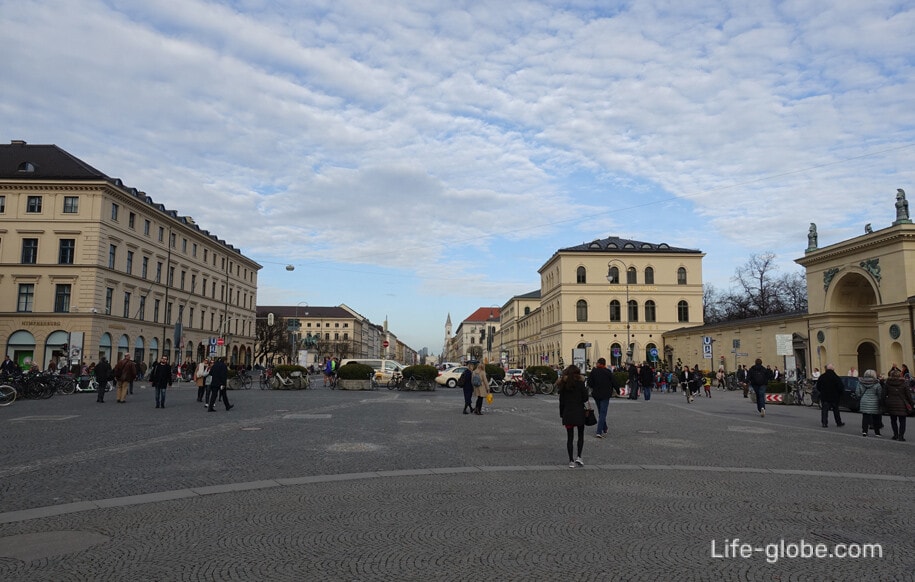


Maximilianstrasse
Maximilian street (Maximilianstraße) is one of the most expensive streets in Germany with the highest retail rents.
The construction of the Avenue began in 1850-ies by decree of the Bavarian king Maximilian II, in whose honor the street was named.
Stretches the Maximilian street in the direction from the West (in the old town of Munich) in the South-East to the ISAR river (the bridge of Maximilian), and connects to a square of max Joseph (Max-Joseph-Platz) with the historical building the Maximilianeum.
The length of the street, together with the Maximilian bridge, is about 1 kilometer.
Along the street there are: 5-star hotel Vier Jahreszeiten Kempinski München, Munich chamber theatre "Kammerspiele", the government building of Upper Bavaria, the five continents Museum, a monument to Maximilian II and the building, known for its galleries, which houses outlets of world brands, designer shops, jewelry stores, boutiques and salons. Read more about maximilianstraße...
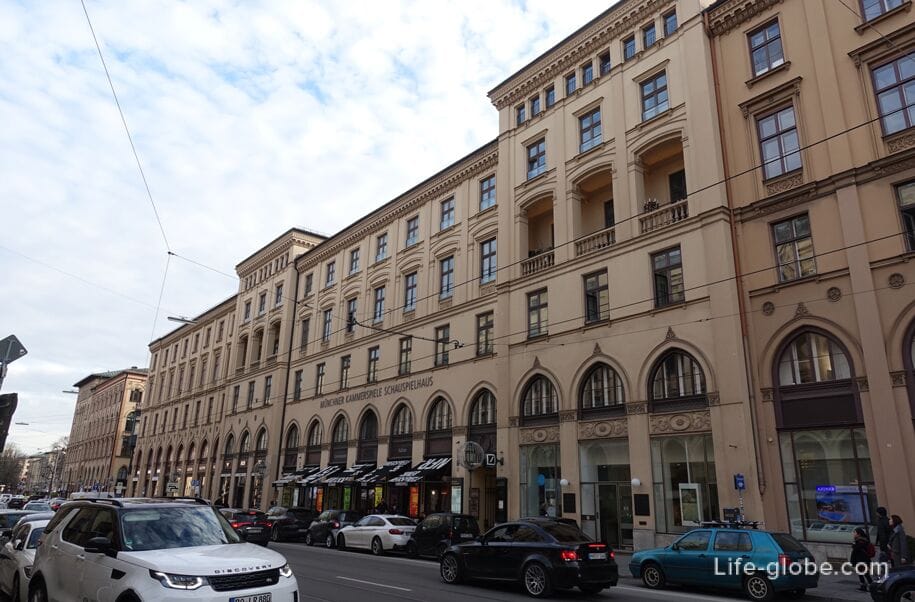
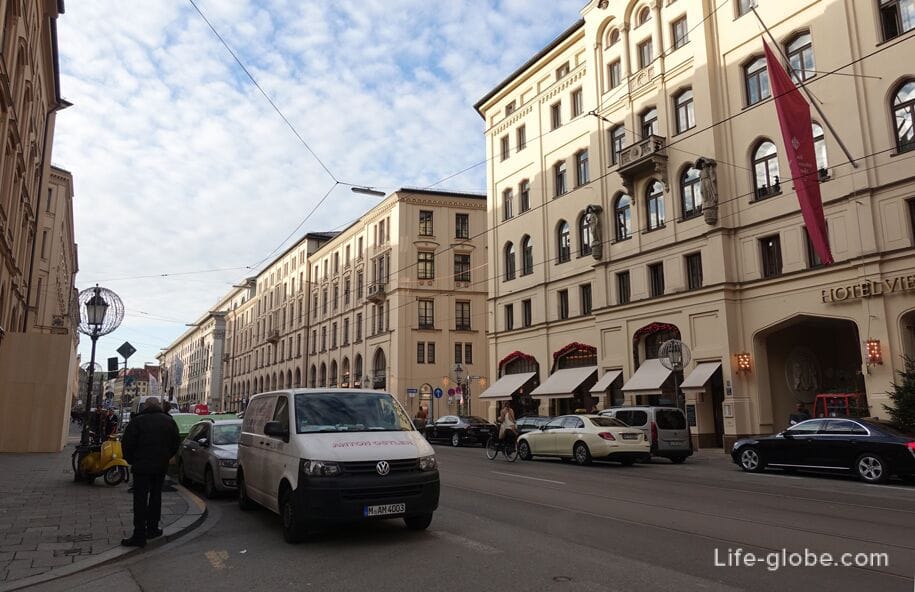
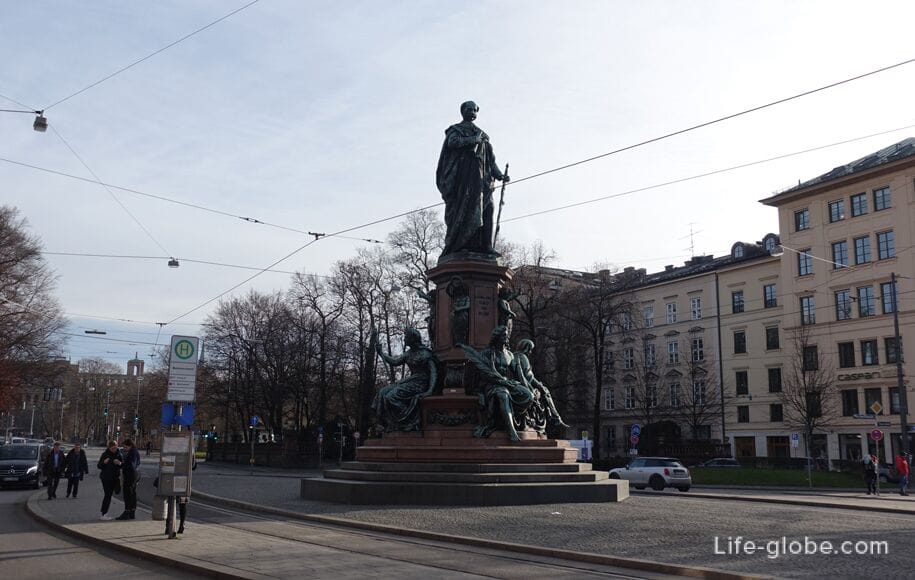
Prinzregentenstrasse
Prinzregentenstrasse (Prinzregentenstraße) was built starting in 1891, as the main street for the middle class by order of the Prince Regent of Bavaria Luitpold, and named in his honor.
The length of the street the Prince Regent is about 3 kilometers.
Prinzregentenstrasse stretches from North-Eastern outskirts of the historic old town of Munich in Eastern direction of the city to the junction with the street Einsteinstrasse (Einsteinstraße).
Along the street there are: the Palace of Prince Charles, house of art, English garden, Bavarian national Museum, collection of Shaka, memorial angel of peace , with an observation deck, Villa stuck, the theatre of the Prince Regent, the stadium of the Prince Regent and the Church of St. Gabriel. Read more about Prinzregentenstrasse...
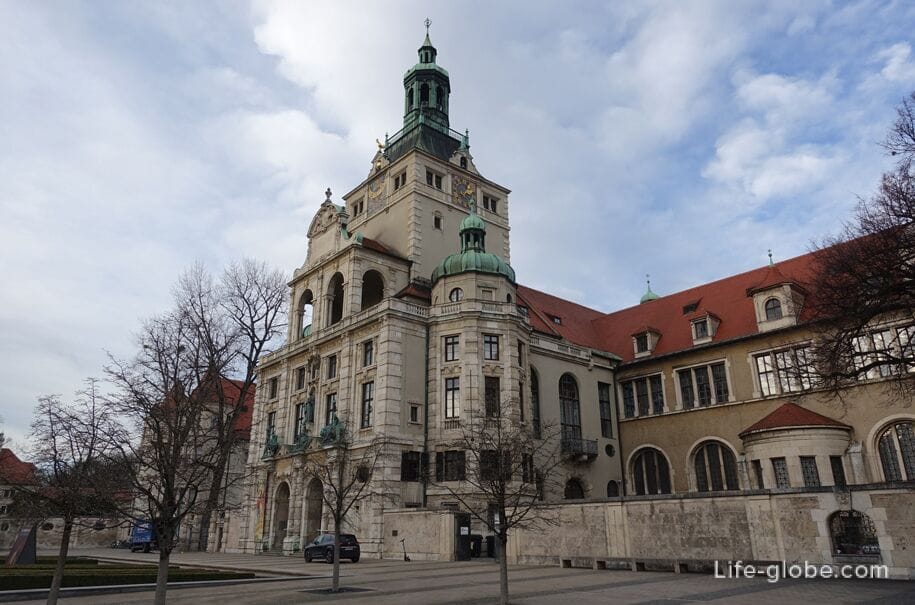

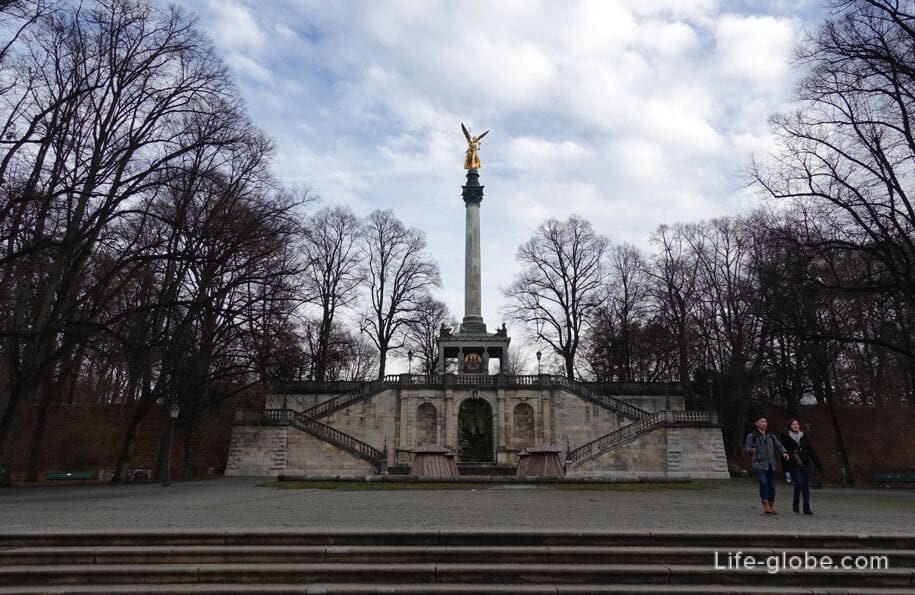
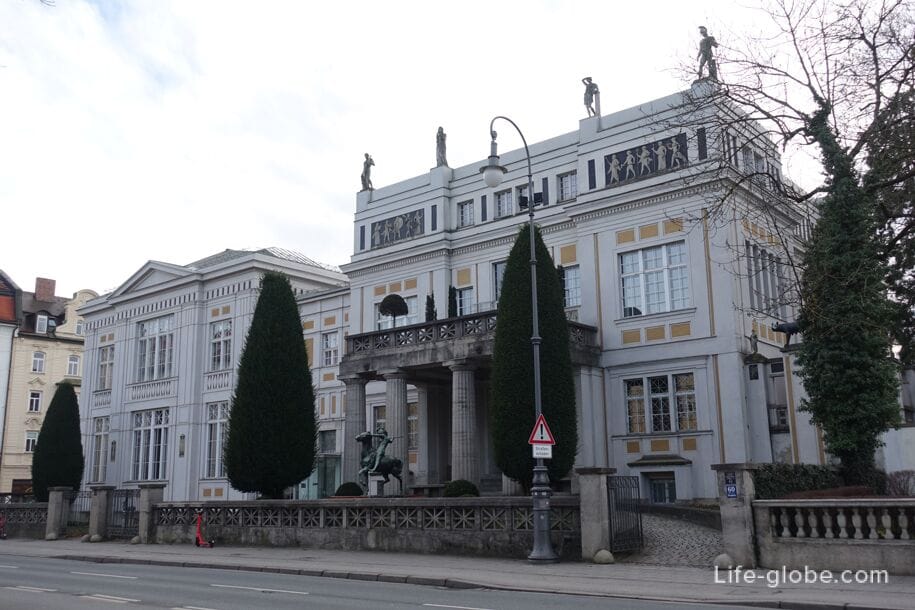
The embankments of the ISAR river
The river ISAR (Isar) flows through the city of Munich, in the direction from South to North.
On warm summer days, the coast of the ISAR in Munich is a popular spot for picnics and sunbathing. In fact, ISAR can swim, there is a place for surfing. On the coast of the allocated BBQ areas. Read more about recreation on the river ISAR in Munich: swimming, barbeque, surfing, walking and...
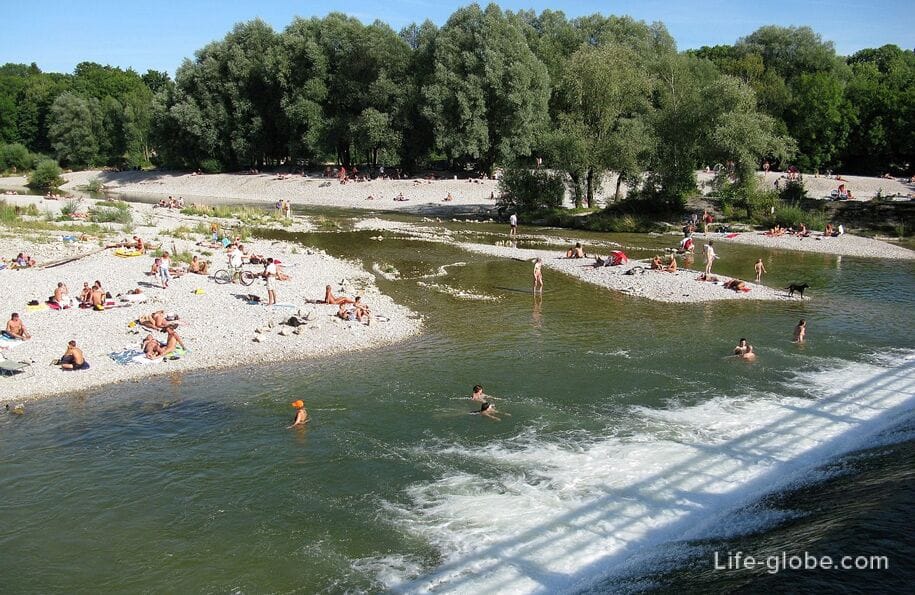
At any time of the year the banks of the ISAR offer guests and residents the places and routes for walking, relaxing or doing some sports (running, bike, videos, etc.).
You can walk along the embankments and parks along the river and(or) numerous bridges over the river that connects the two banks of the river and the Islands situated on the ISAR.
Some of the embankments of the ISAR - street Steinsdorfstr (Steinsdorfstraße) and street Widenmayerstrasse (Widenmayerstraße), draw buildings, some of which are monuments of history and architecture. Read more about the bridges and embankments in the centre of Munich...
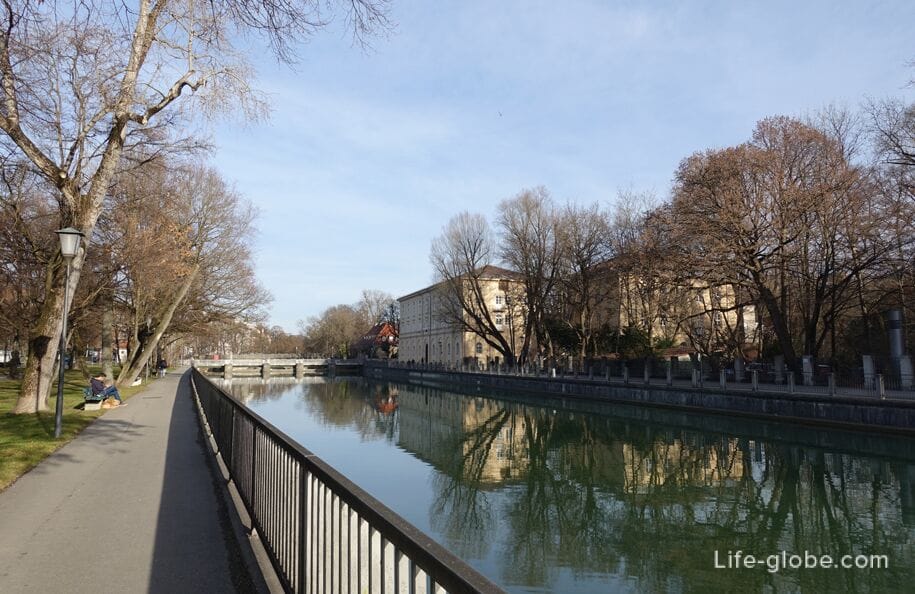

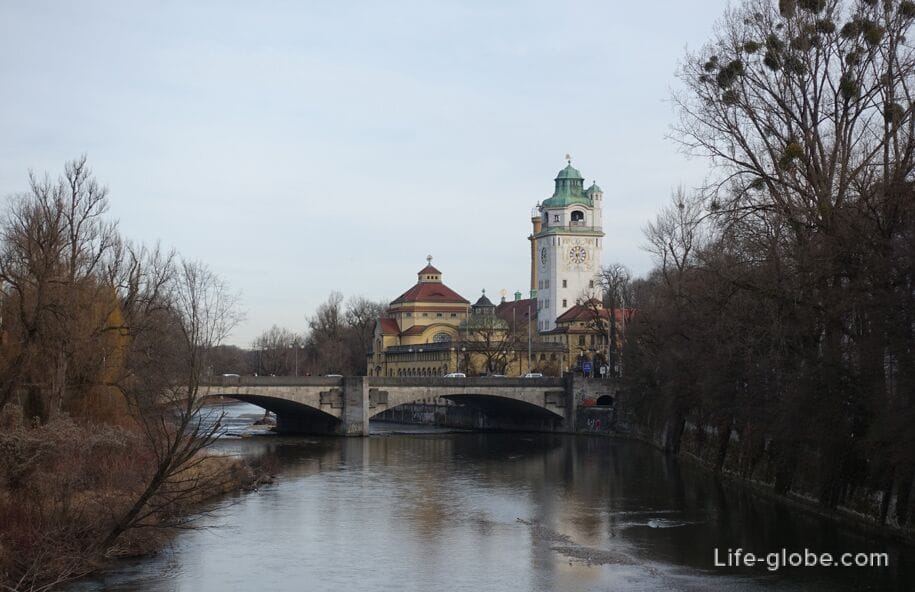
The streets of Maxvorstadt
Street Richard-Wagner-straße
Richard-Wagner-straße underground station (Richard-Wagner-Straße), a street having a length of about 300 meters and built in 1897.
The street was named in honor of the composer Richard Wagner, who lived in the area in the years 1864-1865, at: Brienner Strasse 37.
House of the street was built between 1899 and 1906, mostly by the architect Leopard Romasa. In the design of the street, the architect used various architectural periods, taking into account the taste of late historicism, with the aim to create the impression of "historic" street.
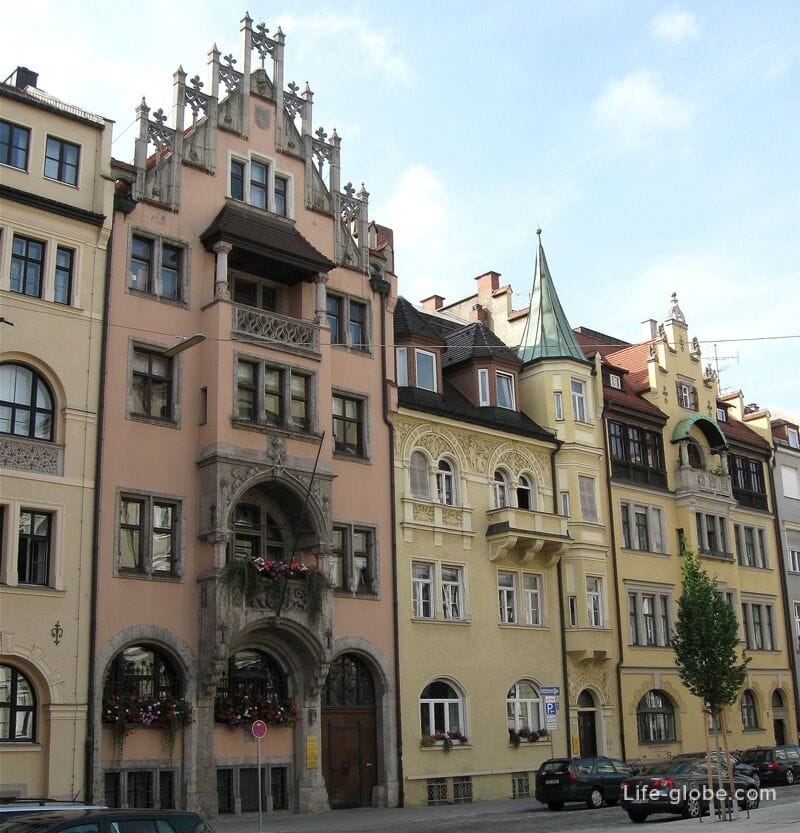

Street Drillmasters and Elisenstrasse
Drillmasters (Prielmayerstraße) and Elisenstrasse (Elisenstraße) - unextended two streets that are parallel to each other are drawn to the West from the Karlsplatz square.
On the streets remarkable:
- Baroque Palace of Justice (cocktail lounge and a library), built in 1890-1897 and having four facades, a Central glass dome and sculptures located on the facades and the roof of the structure;
"The new Palace of justice" (New cocktail lounge and a library), built in addition to the already existing Palace of justice, since the latter is not enough space.
The building was built in 1905, in strong contrast with the "old" Palace of Justice, of red brick in Northern neo-Gothic style with two towers;
old Botanical garden (Alter Botanischer Garten), created between 1804 and 1812 years, and today turned into a public Park.
In the Park: Neptune fountain (Neptunbrunnen); art pavilion (Kunstpavillon), created as an exhibition space; a memorial to the world's first transmission line over large distances Miesbach to Munich in 1882; cafes; places for recreation and walks.
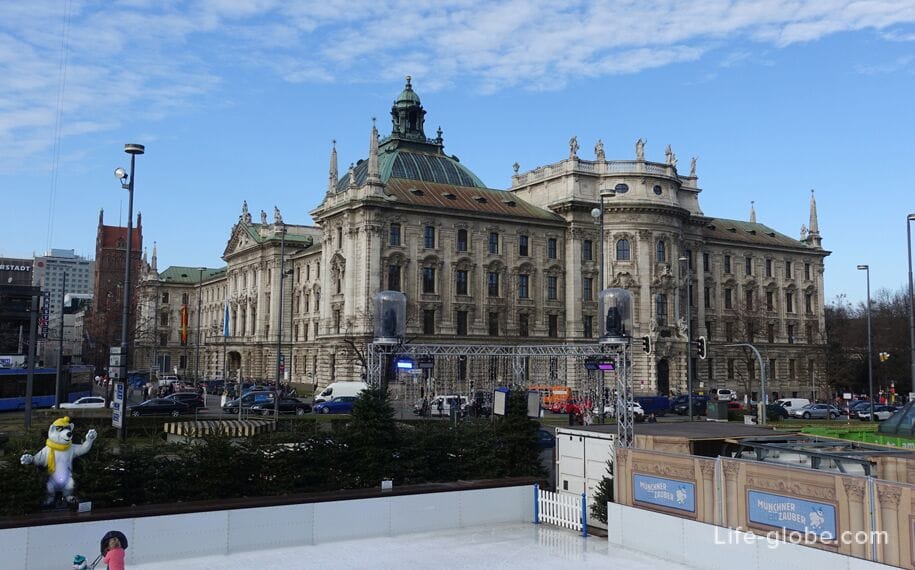
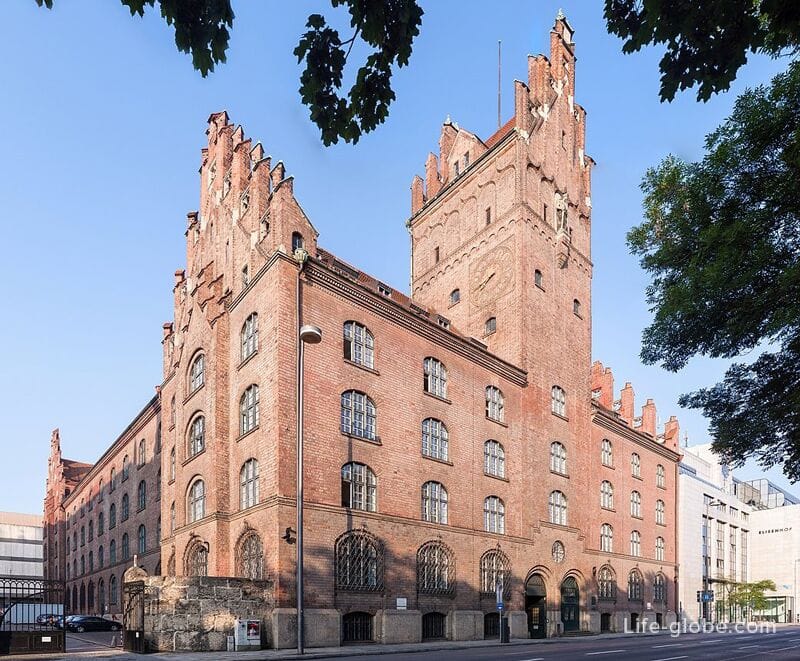
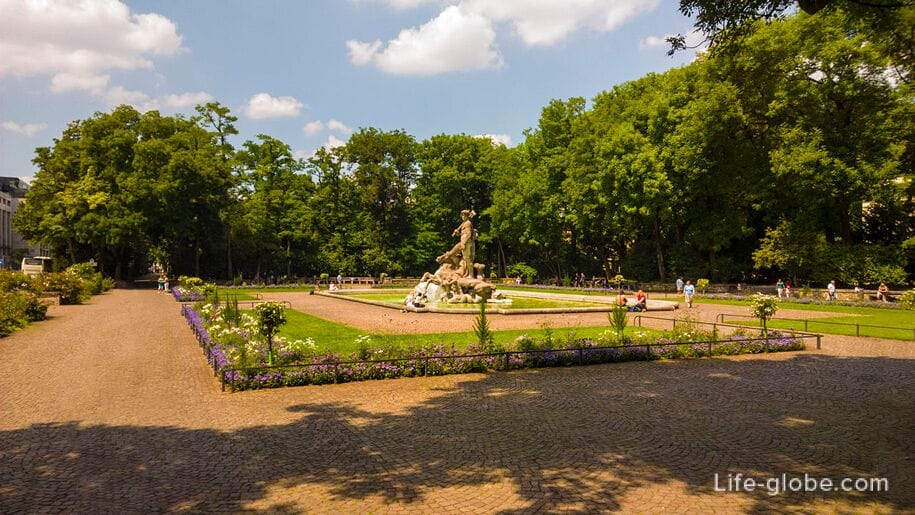
Street Turkenstrasse
Street Turkenstrasse (Türkenstraße) runs along almost the entire district of Maxvorstadt in the direction South-North.
Along remarkable:
- memorial "8 November 1939" erected to commemorate the resistance fighters fighting against the Nazis.
Johann Georg Elser are planned and carried out an elaborate assassination attempt of Adolf Hitler and other senior Nazi leaders - after the explosion on 8 November 1939 in the beer Burgerbraukeller (Bürgerbräukeller) in Munich.
The attempt proved a failure, Elser was arrested and executed.
Monument memorial installed on the facade of the building in a circle, and thus that the elements of the label, "8 November 1939" the visual image explosion. Every evening at 21:20 (exact time of the bombing) numbers and letters of the memorial are illuminated one after the other until you covered the whole inscription;
- Turkish gate (Türkentor / Tormentor) - the only remaining a small part of the former Turkish barracks in Munich, built in 1826 for the Royal Bavarian infantry lifeguards regiment.
The room is the sculpture "Large Red Sphere" (Large Red Sphere), by the American artist Walter De Maria. Read more about Maxvorstadt...
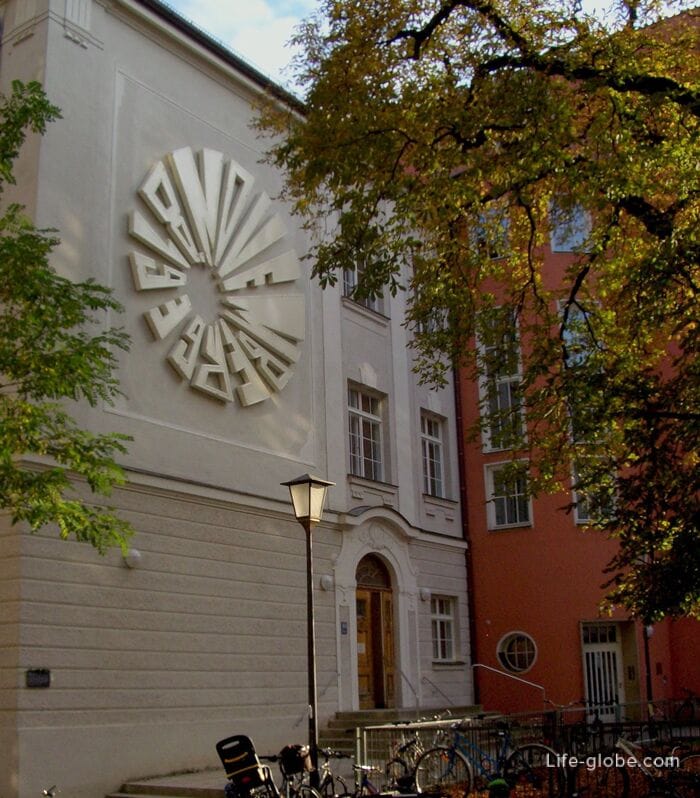
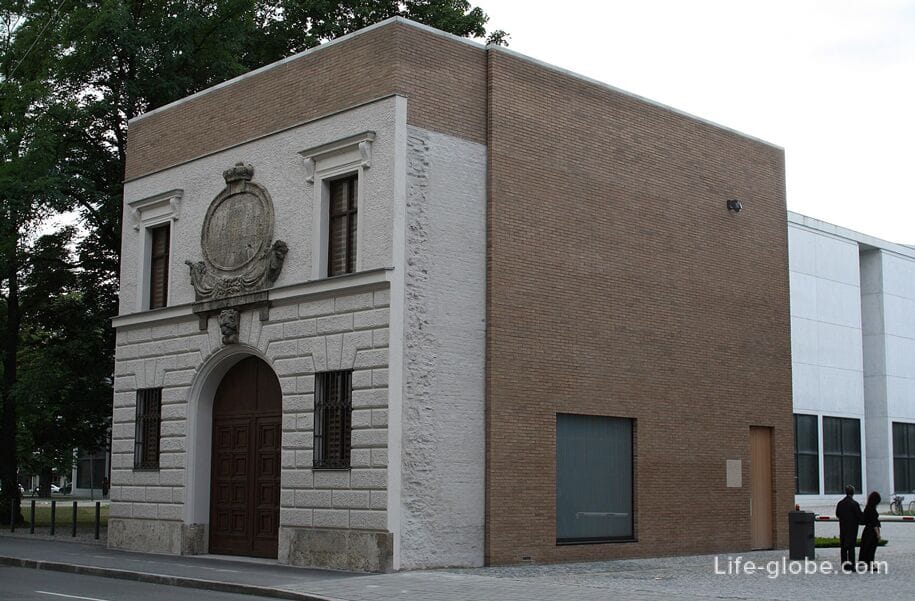

The streets in the district Leel
Lehel is a former small district of Munich, located on the West side of the ISAR river and today is part of the district of Altstadt-Lehel (Altstadt-Lehel).
Having mostly narrow and densely built streets of the district Leel attracts attention with its modest charm and silence.
Some of the houses in Leela built in neo-Baroque or neo-Renaissance. A they even say this is the most beautiful area in the Bavarian capital.
For example, it draws attention to the building, which now houses 4-star hotel Opera, located in the center Leela, to the address: street of St. Anne, 10. Read more about the Altstadt-Lehel...
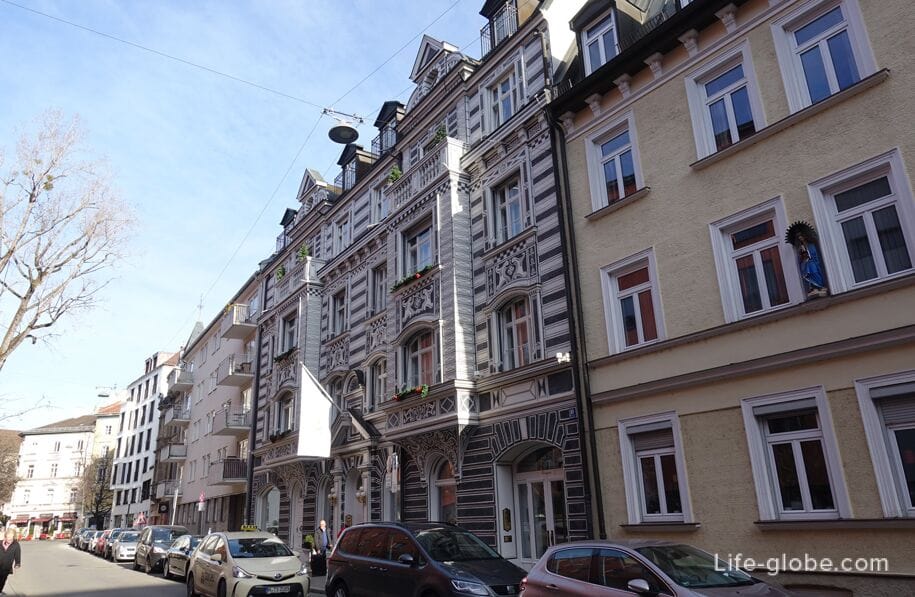

The streets of the district of AU-Haidhausen
The district of AU-Haidhausen (Au-Haidhausen) is located on the East side of the river ISAR.
In the district there are some ex-urban homes of the workers and artisans who today reflect the history, conditions of life and labour of the local inhabitants of yesteryear.
For example: the buildings on the East side of the Vienna square (Wiener Platz / Platz Wiener) and in the Eastern part of the street Preysingstrasse (Preysingstraße). Read more about the district of AU-Haidhausen...
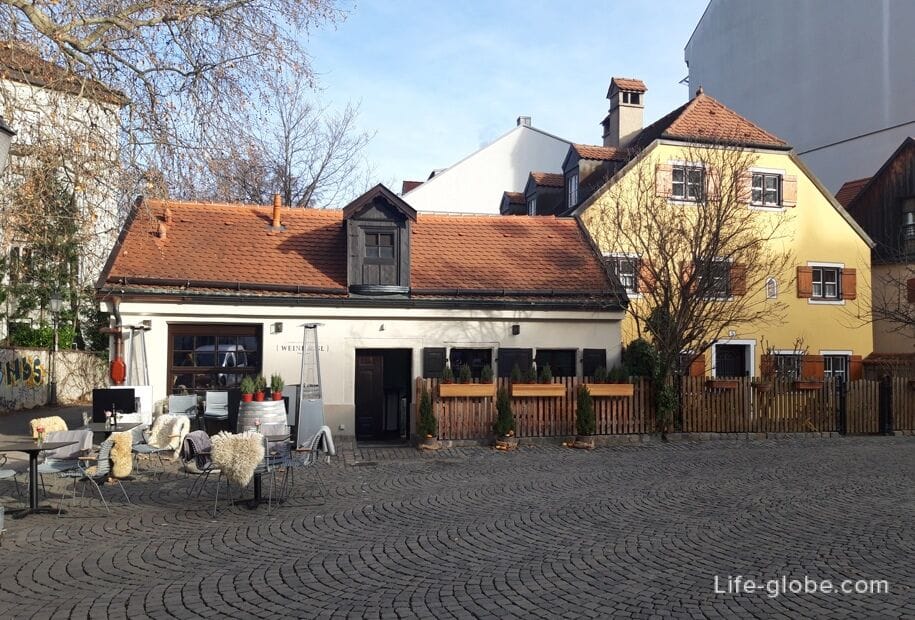
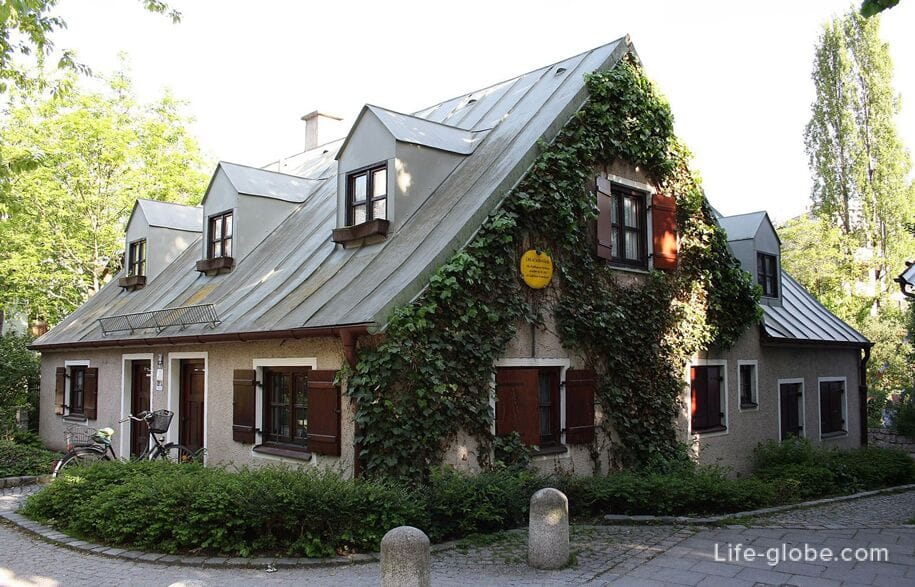
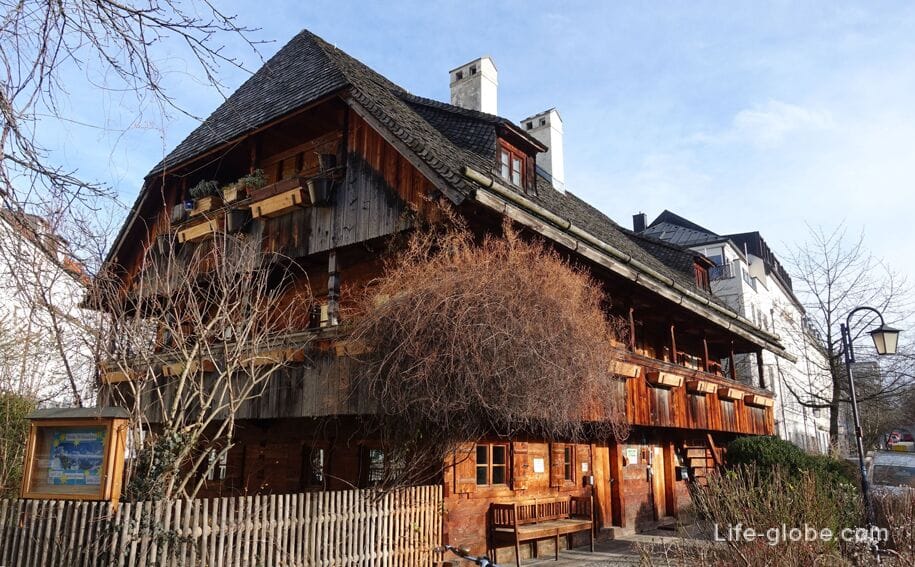
The streets of the district Bogenhausen
The district of Munich (Bogenhausen) has long been a suburb and a place which housed several palaces, and then erected their houses of wealthy citizens.
In the district an attractive residential quarter of "Old Munich" (Altbogenhausen), which is the oldest part of Bogenhausen and along certain streets which are at home in the modern style, neo-Baroque and Renaissance.
In the streets Stegmuller (Stegmühlstraße) and Embalmers (Rambaldistraße) during excavations carried out in 1983, it was discovered the burial of the late stone age and early bronze age burial ground.
On the street Denninger straße (Straße Denninger) is located the Tower of HVB (the HVB-Tower) - tall building that is the headquarters of Unicredit Bank AG, trading floor and data center. Read more about district of Bogenhausen...
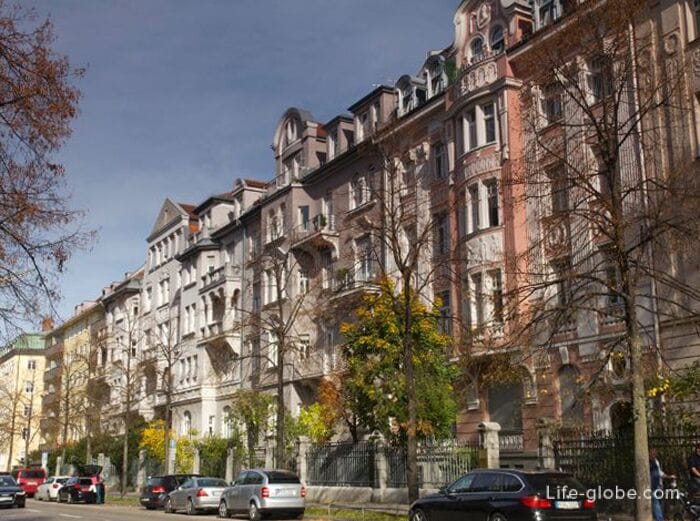
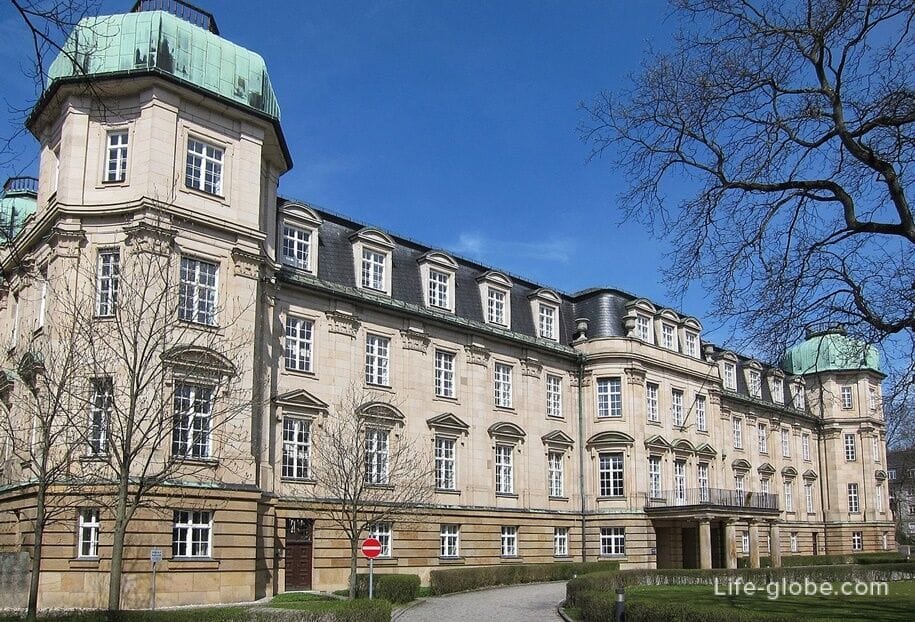

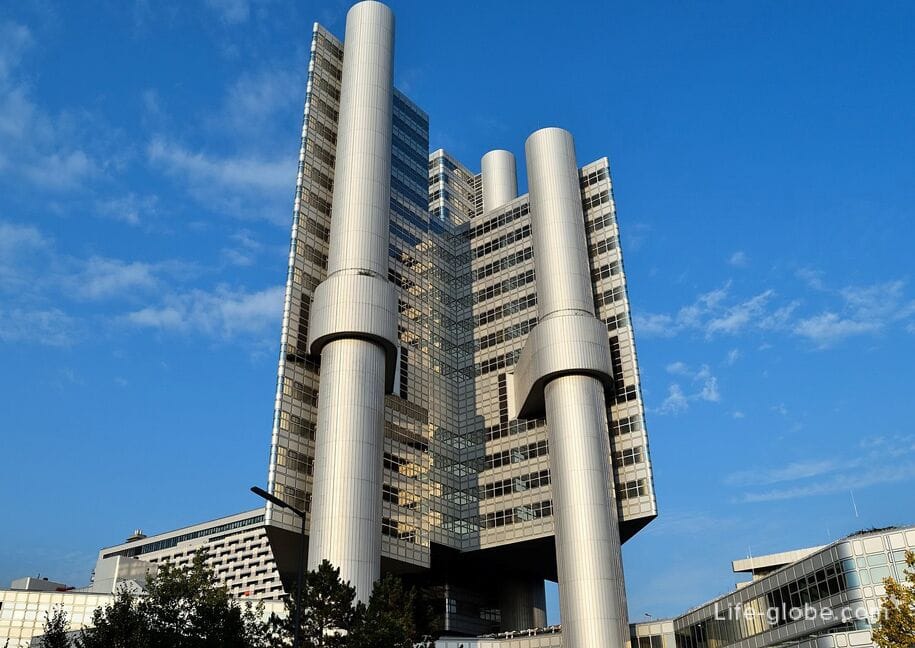
Street Lindwurmstrasse
Street Lindwurmstrasse (Lindwurmstraße) conventionally is the main street of the district Ludwigsvorstadt-Isarvorstadt (Munich-Munich) and leads from the Theresienwiese to the old town of Munich. Read more about the heart of Munich-Isarvorstadt...
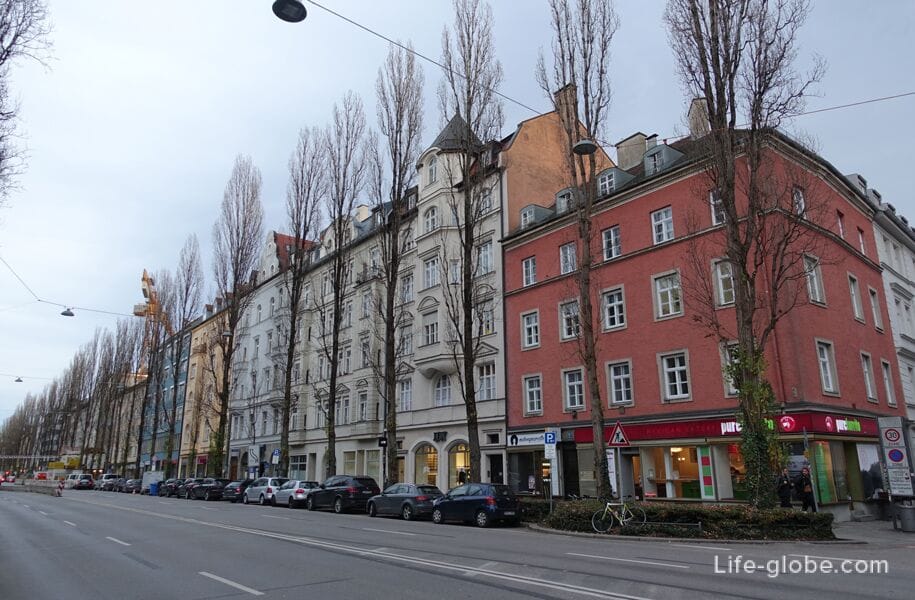
All accommodation in Munich, including along the most desirable streets in the city centre, you can view and book here








